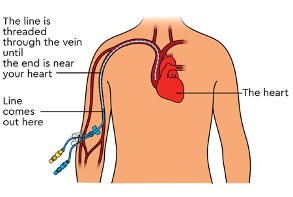Vascular Access Team
We are proud to have a dedicated Vascular Access Team (VAT) at Cheyenne Regional Medical Center. This is a team of highly skilled registered nurses who are specially trained in vascular access insertion using ultrasound imaging for guidance. They ensure the highest quality care for patients who require an intravenous (IV) line.
Vascular Access Team Outpatient Services
- Insert Peripherally Inserted Central Catheters (PICCs) and Midline catheters on selected outpatients.
- Provide education to patients and families about venous access devices
Scheduling Your Outpatient PICC or Midline
- Your Provider must provide the Radiology department with a valid order for a PICC or Midline.
- Once the order is received, the Radiology Schedulers will contact you to schedule a time to come to the Hospital for your line insertion. They can be contacted at (307) 633-7800.
Patient Education (What to Expect) for your Outpatient Line Insertion
Home Care Instructions for Your PICC or Midline
Vascular Access Team Inpatient Services
The Vascular Access Team provides services that include, but are not limited to:
- Insert PICCs, Midlines and other IV lines at the bedside.
- Insert Arterial Lines at bedside.
- Troubleshoot obstructed central line catheters.
- Provide consultation services to enhance the intravenous skills of the nursing staff through bedside teaching; the VAT can be contacted at any time with vascular access questions.
- Provide education to patients and families about venous access devices.
Types of Lines Placed by the Vascular Access Team
- Peripheral intravenous line – peripheral veins are located in the arms. A short peripheral intravenous (IV) catheter is placed in a peripheral vein when therapy is expected to be short-term. These can be placed using ultrasound imaging for guidance if needed.
- Midline catheter – this is a peripheral IV catheter that is longer than a typical IV. It is placed using sterile technique using ultrasound imaging for guidance. It can be used for short term treatments up to 28 days.
- Peripherally inserted central catheter (PICC) – this type of IV line is placed in a larger vein and is used for treatments that may be hard on smaller veins, such as a course of chemotherapy, and for long-term treatments that may take many weeks or even months. The PICC is inserted through a vein in the arm. Using ultrasound imaging for guidance, the tip of the catheter is moved to a large, central vein in the body.

- Arterial Lines – This line is placed into an artery in the wrist to monitor blood pressure for patients who are admitted to the hospital and need accurate, real time monitoring of blood pressure. This line is placed by the VAT using ultrasound imaging for guidance